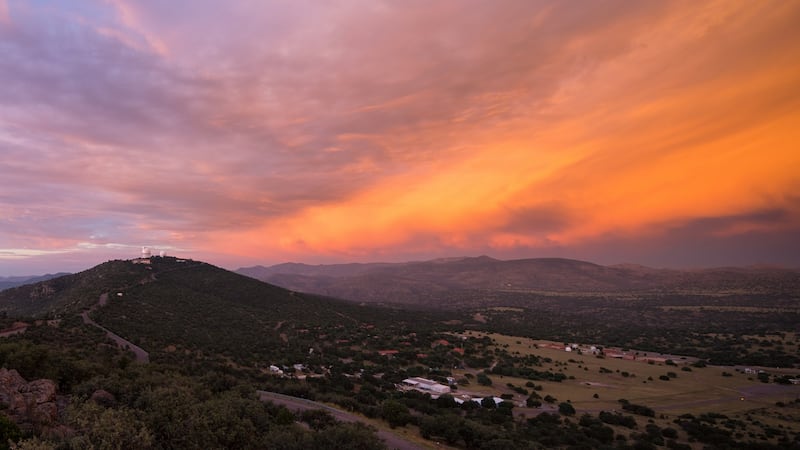Texans love podcasts. Everyone you meet here has heard of Radiolab, The Moth, This American Life, Serial, etc. That's because these folks routinely drive distances that still confound this Irishman. Then again, it's only 400 miles from Malin Head to Mizen Head, while Texas is on a par with France in terms of geographical size. As they say here, it takes a "whole minute" to get anywhere in the Lone Star State. But it's always worth it if you're heading west of the capital, Austin. On this less densely populated side of the state, the sparse towns and small cities that have emerged are surrounded by vast tracts of barren land with an eerily beautiful, 'other worldly' feel.
It is this particular characteristic of the landscape that has given rise to two unique attractions that could only grow out of a place like west Texas.
Marfa – an artistic oasis


The city of Marfa was like so many other sleepy Texan whistle-stops until one of the leaders of the minimalist art movement, Donald Judd, decided he needed to get away from the hectic New York art scene for a while in 1971. The peace and quiet, as well as the vast tracts of uninterrupted land around Marfa, obviously struck a chord with an artist who needed space to realise his vision for works which embody a sense of autonomy and permanence. In the following years, Judd bought nearby houses and tracts of land and turned them into galleries, studios, permanent installations, and so on. The city has been such a magnet for artists and art enthusiasts ever since, it has led to an almost disconcerting level of cosmopolitanism for a place so remote. Aesthetically, Marfa itself isn't all that pretty. But it's telling that a minimalist like Judd appreciated it: the dreary buildings and streets could feature in one of the realist paintings of Edward Hopper.
The Marfa Film Festival, held annually in July, draws in large crowds, as do the frequent temporary art exhibits that pass through. There are plenty of permanent exhibits to keep those with a keen eye for the visual aesthetic interested all year round. But bear in mind, the town gets pretty quiet when there isn’t any major event taking place. One fellow visitor told me about how she deliberately chose to visit when there was nothing big happening because accommodation was virtually impossible to find at other times. Without the crowds, however, she described her visit as almost like being in an abandoned ghost town. Be careful what you wish for.
Perhaps the most famous permanent installation is Prada Marfa, a realistic sculpture of a shop front for the high-end fashion retailer. Designed by artists Elmgreen and Dragset in 2005, it was intended to never be repaired, so that nature could gradually degrade it back into the landscape. Six days after it was completed, however, vandals graffitied the exterior, broke in and stole the handbags and shoes inside.
McDonald Observatory, Davis Mountains
Artist Donald Judd may have moved to Marfa because of the abundance of space. Astronomers chose west Texas as the location for one of the world’s most sophisticated observatories for similar reasons. Set in the foothills of the Davis Mountains, the remote location for the McDonald Observatory allows astronomers to observe the night sky with little or no light pollution from nearby cities or towns. You haven’t seen the stars until you’ve seen them from this vantage point.
The Davis Mountains are situated in the Chihuahuan Desert – considered to be one of the most diverse deserts on the planet. Aside from the obvious cacti, snakes and scorpions one might associate with the hot, dry terrain which makes up so much of west Texas, there are also deer, wild boar, mountain lions and a miserable little creature known locally as a javelina. Similar in appearance to a pig, javelinas are actually more closely related to hippos. Short-tempered and always looking for a fight, the 'skunk pig' (its other common moniker) is the Jack Russell of the peccary world: small-man syndrome has turned them into vicious little buggers who use their tusks to attack other animals and, in some cases, humans.
The West Texas Underground
The seemingly never-ending horizon in this part of the world is broken only by the occasional mountain range – insignificant in size by American topographical standards, but still grand enough to impress. Most of the action, from an environmental perspective, seems to take place underground in Texas. Aside from the subterranean bounty of oil and gas prospectors continue to find, the state boasts one of the highest number of accessible caves in the United States. There are also several, famous natural springs pumping clear, cool freshwater to the deserted surface above. Bahlmorea State Park has one of the largest in west Texas. A constant flow of freshwater is provided by the San Solomon Springs beneath servicing a manmade pool above. No chlorination is required in the water and the water reflects a stunning deep blue. Used for both swimming and scuba diving, Bahlmorea pool stays at a consistent temperature (23°C) all year round and is up to 10 metres deep in parts.









